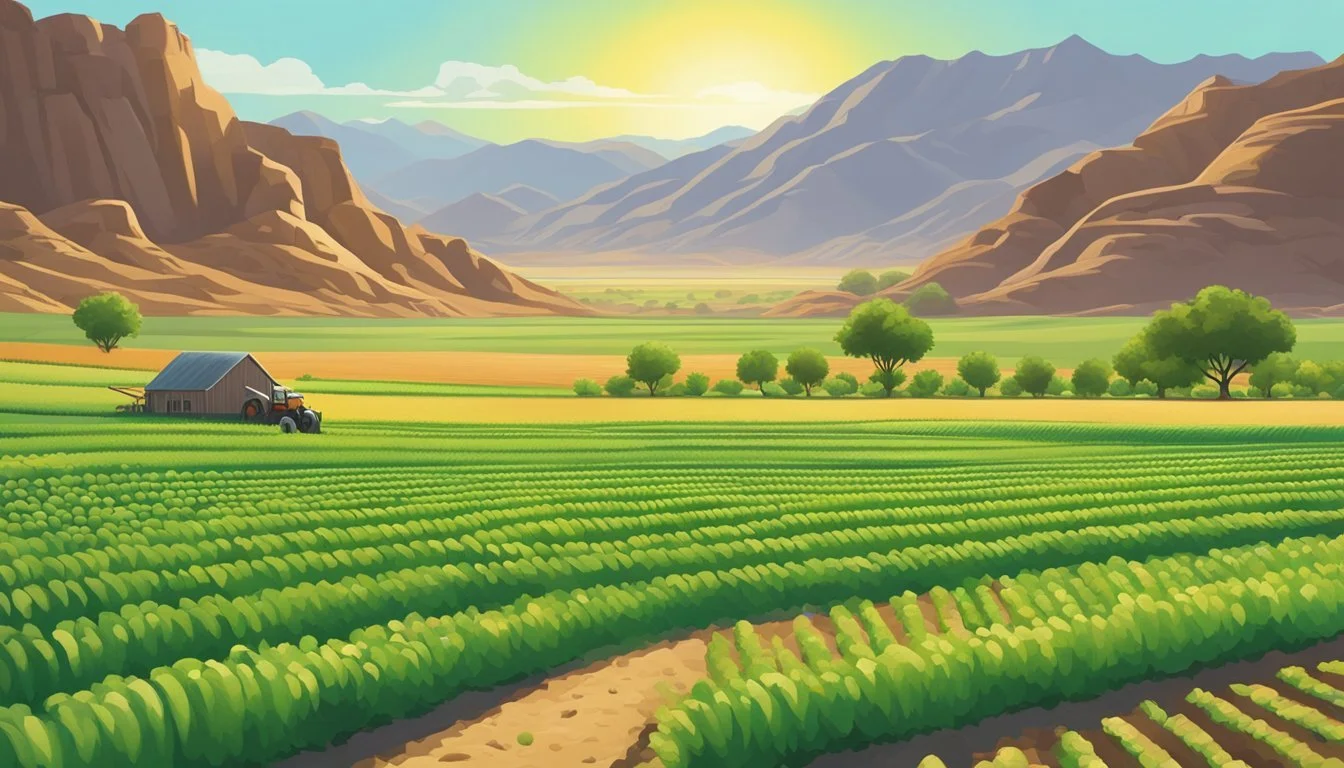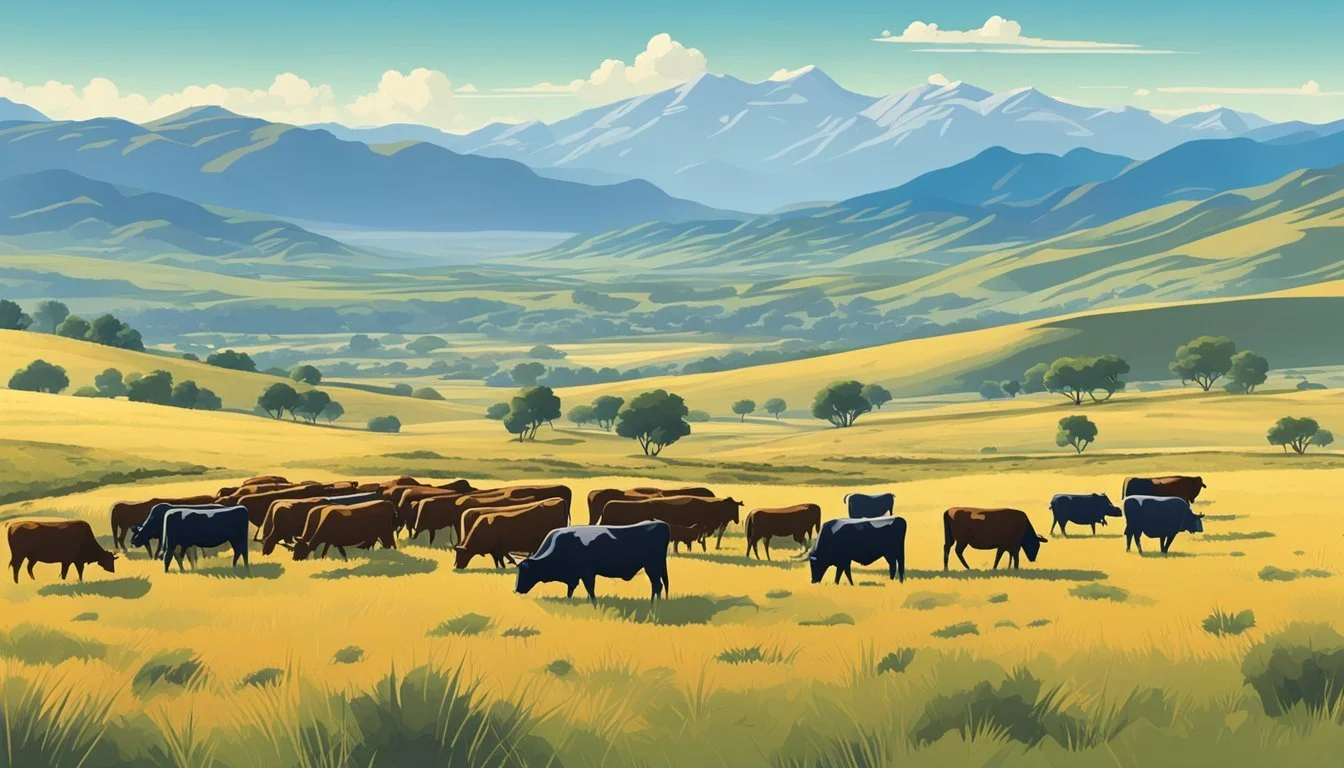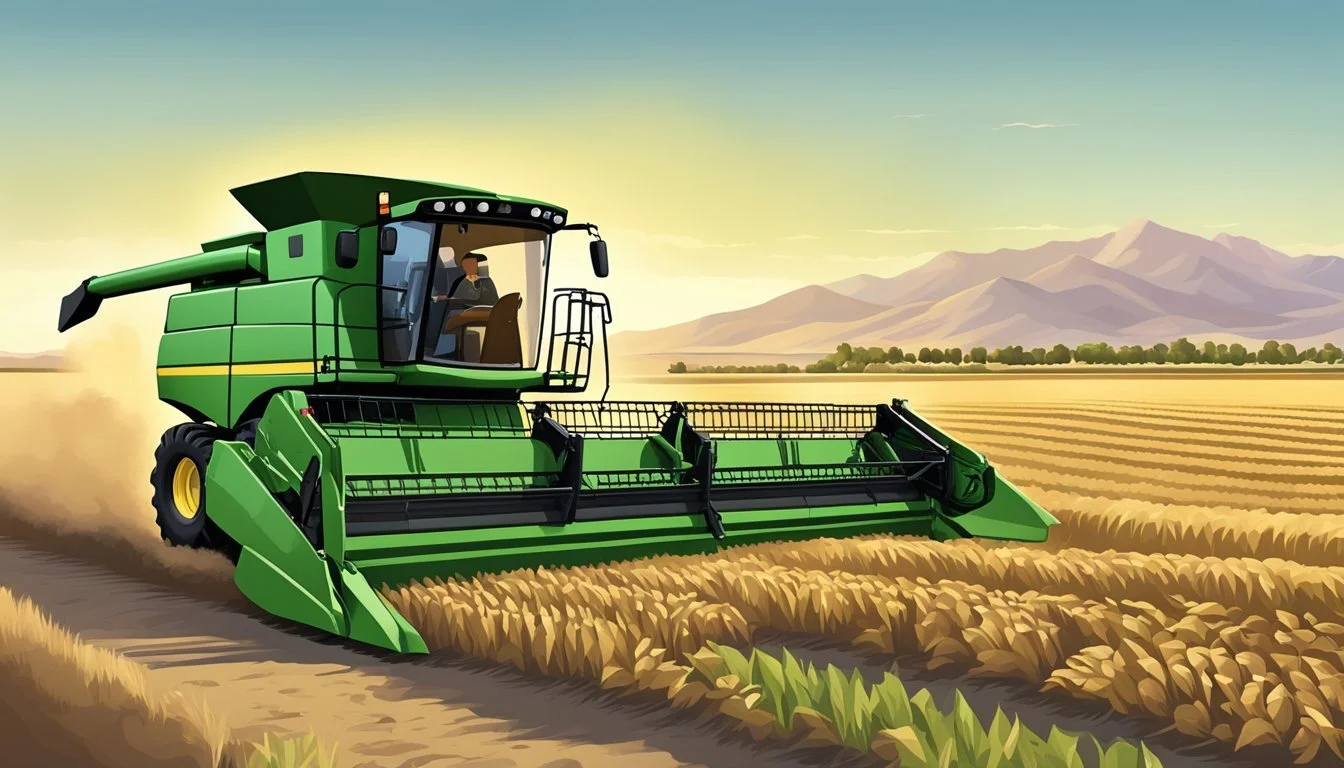Guide to Farming in Nevada
Essential Tips for Arid Climate Agriculture
This Article is Part of Our State by State Farming Guide
In the diverse landscape of Nevada, agriculture plays a crucial role in the state's economy, with a particular emphasis on range livestock production. This sector is predominantly composed of cattle and calf operations, where cow-calf enterprises are the norm. Nevada’s arid climate and its expansive rangelands lend themselves naturally to the success of such operations, providing a suitable environment for these animals to thrive.
The state’s agricultural industry extends beyond livestock, encompassing a variety of enterprises. Sheep, lambs, dairy, and hog farming also contribute to Nevada's agricultural profile. For those interested in embarking on agricultural ventures, Nevada presents opportunities for both seasoned and beginning farmers. Extension programs and university resources provide guidance and support, acknowledging the specific challenges posed by the state’s unique climate and terrain.
The University of Nevada, Reno plays a pivotal role in supporting the agricultural community by offering valuable research on crop and livestock income potential, evaluating market conditions, and exploring alternative crops suited to the state's environment. This scientific backing ensures that farmers and ranchers in Nevada can make informed decisions, optimize their operations, and remain competitive in a dynamic industry.
Understanding Nevada's Climate and Soil
Nevada's diverse agricultural landscape is shaped largely by its climate and soil characteristics which vary significantly from north to south.
Unique Climate Characteristics
Nevada experiences a predominantly arid to semi-arid climate with notable differences between the northern and southern regions of the state. The northern part has colder winters, whereas the southern region is characterized by very hot summers with temperatures often surpassing 100 degrees Fahrenheit. Rainfall is relatively scarce throughout the state, with an average precipitation that can dramatically affect farming practices.
Soil Types and Quality
The soils in Nevada are as varied as its climate. A primary soil type found here is the Orovada series, recognized as the state soil. It’s present across more than a million acres and is known for its agricultural benefits. Other prevalent soil types include:
Clay
Sandy
Loamy
Given the arid conditions, water availability is a critical factor in growing crops, and the amount of pore space in soil affects its ability to retain both water and air. In proper proportions, these characteristics provide the essential support for plant roots and nutrient uptake. Maintaining soil health is fundamental, with conservation techniques such as reduced tillage and the use of perennial crops being employed to improve soil quality and farming sustainability in Nevada's unique environment.
Agricultural Practices in Nevada
In Nevada, agricultural practices are tailored to the state's arid climate and soil conditions, focusing on effective crop and livestock management, sustainable techniques, and innovative water management strategies.
Crop and Livestock Management
Crop production in Nevada involves a range of plants suitable for the area's climate, including forage crops like alfalfa, as well as vegetables and fruits. The USDA plays a significant role in supporting crop management through guidance on best practices. Livestock farming primarily involves cattle and sheep, with emphasis on larger ranches located in the northern part of the state. Effective management is crucial for both crops and livestock due to Nevada's unique environment.
Sustainable Agricultural Techniques
Sustainable agriculture is a cornerstone of modern farming in Nevada. The state encourages practices that promote soil health, water conservation, and reduced reliance on chemical inputs. Farmers are adopting strategies such as crop rotation, integrated pest management (IPM), and the use of cover crops to maintain ecological balance and improve long-term productivity.
Water Management and Irrigation
Water usage is a critical concern in Nevada's agricultural sector due to the state's dry climate. Irrigation systems are widely utilized, with farmers investing in efficient technologies like drip irrigation to minimize water loss. The management of water resources is supported by state regulations, ensuring that agricultural practices do not overextend the limited water available while aiming for optimal irrigation of crops.
Key Crops and Produce
Nevada’s arid climate presents unique challenges and opportunities for farming, shaping the state's agricultural output. Despite the harsh conditions, farmers successfully raise a variety of crops, with certain areas showing a particular affinity for certain types of produce.
Fruit and Vegetable Cultivation
Nevada’s fruit and vegetable production takes advantage of specific regional conditions. Southern Nevada has been successful in growing Opuntia ficus-indica, a type of cactus that produces fruit with minimal water use. Additionally, a variety of vegetables thrive in Nevada's soil, including potatoes, onions, garlic, and a selection of leafy greens that complement the state's agricultural profile.
Fruits: Opuntia ficus-indica, some other fruits
Vegetables: Potatoes, onions, garlic, leafy greens
Grains and Field Crops
Grains and field crops are staples in Nevada’s agricultural landscape, with several key crops dominating production. Alfalfa hay and alfalfa seed stand out as critical crops due to their adaptability to the local climate and high demand as livestock feed. Fields also abundantly produce barley and corn, integral to both animal feed and the needs of the state's burgeoning food processing industry.
Alfalfa: A leading crop for both hay and seed
Grains: Barley, Corn
Through strategic crop selection and innovative practices, farmers in Nevada harness the state’s climate to grow a diverse range of agricultural products.
Livestock and Rangeland Management
Effective livestock management in Nevada is essential for sustainable agriculture, with a focus on cattle and dairy farming as well as the raising of sheep and other livestock. It encompasses the strategic use of rangelands, where proper timing and techniques are crucial for optimizing livestock health and productivity.
Cattle and Dairy Farming
Nevada's cattle industry revolves around both beef and dairy production. Cattle and calves make up a significant portion of the agricultural output, with a range of practices designed to enhance the quality of beef and milk products.
Beef Production: Grazing strategies include the utilization of natural service combined with estrous synchronization and timed artificial insemination to increase herd productivity.
Dairy Production: The focus is on cow health with specific attention to the mammary system; proper weaning time is critical for cow condition.
Forage for cattle primarily includes hay, which is a crucial element for feed, especially in dormant seasons when rangeland productivity is low.
Sheep and Other Livestock
The management of sheep and the production of lambs are carefully tuned to the state's rangeland conditions. Nevada also supports the raising of hogs and range livestock production.
Sheep Farming: Producers follow targeted guidelines to maintain herd health and ensure the quality of lamb.
Rangeland Practices: Incorporate long-term and short-term monitoring to adapt and refine grazing practices.
Emphasizing sustainable practices ensures that both livestock health and rangeland ecosystems are preserved for continuous productivity and biodiversity.
Harvesting and Yield
Effective harvesting and yield management are critical to farming success in Nevada, taking into account the state’s climatic conditions and market demands.
Optimizing Harvest Strategies
The timing of harvest in Nevada largely depends on the crop type—whether it is a winter or spring variety. For instance, hay may be cut several times a season, provided that irrigation is available. On the other hand, grain crops such as wheat and barley have specific harvest windows that ensure peak quality and minimize losses. Precise timing is crucial, as it affects both the quantity and quality of the final product. Famers often employ market analysis to determine the best times for harvest to align with market demand for crops like fruits and vegetables.
Harvest calendar for Nevada:
January-February: Dormant season for most crops.
March-April: Early greens and lettuces may be harvested.
May-June: Prime harvest for spring crops.
July onwards: Succession harvesting for various vegetables and fruits according to growth cycles and weather patterns.
Utilizing modern equipment and sowing methods like row-cropping can optimize the use of space and facilitate efficient harvesting. Additionally, soil preparation and selecting appropriate cultivars for Nevada’s unique soil and climate are indispensable for a successful yield.
Yield Prediction and Maximization
Yield projection is vital for planning and resource allocation. Farmers in Nevada use a combination of traditional knowledge and modern tools to predict yields. Variables considered include plant age, prevailing weather, and local climate trends. Success in maximization of yields depends on the alignment of these factors with efficient farming practices.
Researchers and agricultural experts in Nevada have developed guides and calculators to estimate crop yields. For example:
Resource Guide to Organic and Sustainable Vegetable Production (ATTRA)
Postharvest Handling of Fruits and Vegetables (ATTRA)
Harvest Calculators:
Estimating crop yields
Seed Quantity Calculator: Determines the number of seeds or plants needed for a specific area of land.
Such tools are valuable in yield maximization as they allow for precise planning and adjustments to be made for enhancing the harvest. Planting density, irrigation management, and the use of fertilizers are fine-tuned to achieve the highest yields per acre while maintaining product quality to meet market requirements.
Economic Aspects
The economic landscape of farming in Nevada is shaped by its agricultural producers, who contribute significantly to the state's economy, and the market dynamics that drive trade and determine the value of Nevada-grown products.
Market Trends and Trade
Nevada's agriculture sector is impacted by both domestic and international market trends. In recent years, Nevada-grown products have gained momentum in local and regional markets, bolstering the popularity of locally grown and family farm products. Trade opportunities also influence market positions, with Nevada's agricultural producers responding to global demands while balancing local consumption needs.
Agricultural Producers and Contributions
Agricultural producers in Nevada play a notable role in the state's economic vitality. They provide thousands of jobs and contribute billions to the economy through diverse activities in ranching and farming. The emphasis on Nevada-grown produce has seen an uptick in economic output, with substantial contributions from food and beverage manufacturing. Below is a brief overview of their contributions:
Jobs: The state's food and agriculture sector supports over 16,000 jobs.
Economic Output: The sector contributed well over $1 billion to Nevada's economy.
Multiplier Effect: For every dollar spent in the agriculture sector, an additional $0.70 is generated in economic activity.
The resilience and importance of Nevada's agricultural producers are underscored by these figures, attesting to the sector's role as a fundamental pillar of the state's economy.
Resource and Extension Services
In Nevada, resource and extension services play a pivotal role in supporting the state's agricultural community through education, outreach, and assistance programs. These services bridge the gap between research and practical application, ensuring farmers and ranchers have access to the latest industry insights and technologies.
University and Educational Programs
The University of Nevada, Reno operates extensive extension services with a focus on practical farming and ranching advice. They provide information, programs, and training that are research-based to tackle local agricultural challenges effectively. Programs such as the Herds & Harvest Program are tailored specifically to support beginning farmers and ranchers, acknowledging the unique hurdles they face in the first ten years of operation. Furthermore, the university features programs on Forage & Food Crop Production, delivering science-based information and risk management education to help producers maximize their yield and sustain their operations.
Featured Programs:
Risk Management Education
Beginning Farmer and Rancher - Herds & Harvest Program
Grow Your Own, Nevada!
Governmental Support and Certification
The Nevada Department of Agriculture and the U.S. Department of Agriculture (USDA) offer crucial support and certification programs to farmers and ranchers. Extension services include assistance for farmers and ranchers to gain certifications and improve their practices. The USDA is particularly involved in supporting new agricultural businesses by recognizing individuals operating a farm or ranch for less than ten years. Governmental support extends to numerous aspects of agriculture, ensuring that Nevada's agriculture industry, which significantly contributes to the state's economy, continues to thrive.
Key Support Areas:
Technical assistance
Certification programs
Grants and funding opportunities
Environmental and Safety Concerns
In Nevada’s farming industry, attention to environmental and safety concerns is paramount to ensure the production of safe and nutritious crops. The proper management of pesticides and nutrients is essential to maintain the quality and flavor of produce without compromising the wellbeing of the environment and consumers.
Pesticide and Nutrient Management
Pesticides are used to protect crops from pests and diseases, but their application requires careful management to avoid adverse effects on the environment and to ensure the safety of food. Farmers in Nevada must adhere to state guidelines that regulate pesticide usage. They should also implement integrated pest management (IPM) strategies to reduce the reliance on these chemicals. This includes:
Regularly monitoring pest populations.
Using pest-resistant crop varieties.
Applying biological control methods.
Nutrient management involves the appropriate use of fertilizers to provide essential nutrients to crops. In Nevada, farmers must balance crop needs with the natural fertility of the soil to prevent nutrient runoff into water supplies. Utilization of compost can enhance soil health, contribute to nutrient composition, and reduce the need for chemical fertilizers. Practices include:
Soil testing to tailor fertilizer application.
Using precision agriculture technologies.
Ensuring Safe and Nutritious Produce
Farmers strive to deliver produce that is both safe to consume and rich in nutrients. They achieve this by employing a variety of techniques that not only preserve but can also enhance the natural flavor and quality of fruits and vegetables. To maximize nutritional value and safeguard their quality, the following measures are taken:
Implementing strict water quality standards to avoid contamination.
Applying Good Agricultural Practices (GAPs) from planting to harvest.
These careful practices support the production of wholesome, flavor-rich, and nutritious foodstuffs, contributing to a food system that prioritizes consumer health and environmental sustainability.








